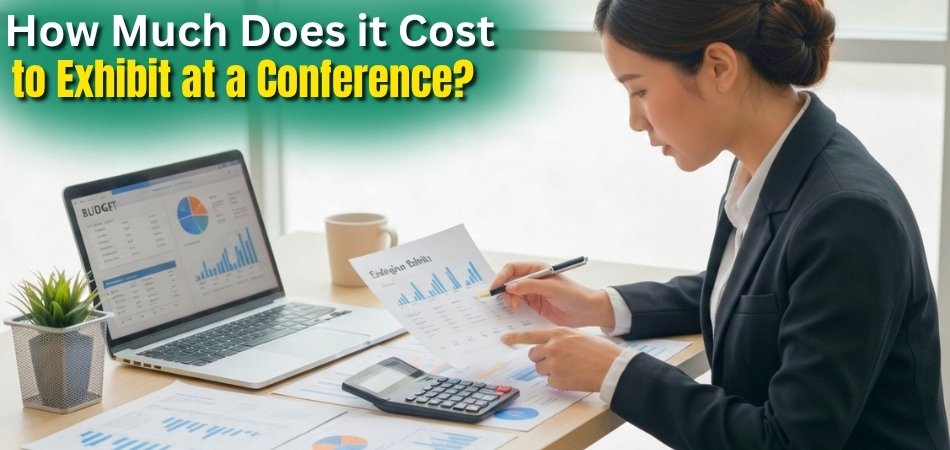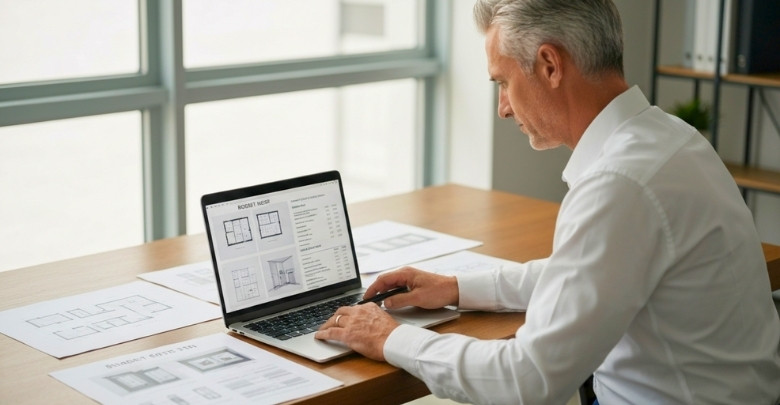Exhibiting at a conference is a great way to show your brand and connect with people. Many businesses wonder about costs. So, how much does it cost to exhibit at a conference?
Exhibiting at a conference typically costs between $25,000 and $60,000. Major expenses include booth space ($10,000–$30,000), design and setup ($5,000–$15,000), marketing ($2,000–$10,000), technology, and travel. Planning early and managing staff, materials, and promotions wisely helps control costs and maximize event results.
Curious about the full financial picture? This article provides all the information needed to budget smartly and make your next conference a big success.
How Much Does it Cost to Exhibit at a Conference?
Exhibiting at a conference can be a great way to promote your brand. It helps you meet people, share ideas, and grow your business. But to do it right, you need to plan your budget carefully. Below, we’ll go over the main costs so you know where your money goes.
Booth Space
Booth space is the first thing that takes a big part of your money. A regular 10×10 booth can cost from $10,000 to $30,000, depending on the event. Larger booths or better locations can raise the price even more. Booking early can help you save a good amount.
Booth Design And Setup
Design and setup can quickly use a large part of your budget. Simple booths cost less, but custom designs with lights, panels, and signs can reach $15,000 or more. Many exhibitors spend money here to make their space more eye-catching. Reusing booth materials can help lower costs next time.
Technology And Equipment
Adding big screens, projectors, or interactive touch systems needs extra money. Tech rentals range from a few hundred to several thousand dollars. For example, a screen setup can cost $1,000 to $5,000, depending on size and type. Especially for big events like conference in Canada, the USA, or other countries, tech upgrades draw more visitors.
Marketing And Promotions
Marketing also needs a good money plan. You’ll spend on banners, flyers, giveaways, and digital ads. These costs usually run between $2,000 and $10,000, depending on the scale. Promoting early can bring more visitors to your booth and help you stand out among competitors.
Travel, Shipping, And Staff
This part includes airfare, hotel stays, meals, and shipping booth materials. Depending on distance and team size, this can add $5,000 to $15,000 to your total cost. Planning early helps reduce travel rates. Keeping staff numbers small can also save extra money.
Total Estimated Cost
When you add up all the money parts, the total often reaches $25,000 to $60,000 for one conference. The price changes with location, booth size, and marketing goals. Setting a clear spending plan helps control costs. A well-managed budget ensures good results without wasting money.
Exhibiting at a conference can cost a lot, but it’s worth it. Knowing how much money each part needs helps you plan smarter. With good budgeting, you can make a strong impact without overspending. The key is to focus on value, not just on how much you spend.
Hidden or Extra Costs Exhibitors Should Know About
Planning to show your products or services at a conference is exciting. But it’s key to know all the costs. Some fees are not obvious at first glance. These extra costs can add up quickly. Be ready for them to keep your budget on track.
- Electricity Fees: You will need power for your lights and screens. Venues often charge extra for each plug. This fee can be hundreds of dollars.
- Internet Charges: Wi-Fi at events is rarely free. Getting a strong internet link for your booth costs money. Fast, stable connections are very important.
- Furniture Rental: Your booth space might not come with tables or chairs. Renting these items can add a lot to your bill. Look into what is included.
- Carpet and Flooring: Some places make you use special carpet. This flooring must fit their rules. It is another cost you need to plan for.
- Travel Costs: Your team needs to get to the event. Flights, hotel rooms, and food add up fast. Do not forget local travel too.
- Shipping and Handling: Getting your display items to the event costs money. Sending them back home also has a price. Plan for both ways.
- Storage Fees: You might need to store boxes or items. Some venues charge for keeping your things. This happens before and after the show.
- Cleaning Services: Your booth needs to look good every day. Daily cleaning may not be free. Check for extra charges in your contract.
Knowing about these extra costs helps you plan better. Always ask for a full list of all possible fees. This way, there are fewer surprises. Good planning makes your event experience much smoother and more affordable.
How Do Booth Size and Design Impact the Total Cost?
The size of your booth matters a lot for your budget. A bigger space often costs more money. The way your booth looks also changes the price. Simple designs are cheaper. Fancy designs will cost you more. Both factors are big parts of your total spend. Here’s how booth size and design can directly influence your total event cost.
Larger Area Means Higher Rental Cost
More space usually means a higher rental fee. Venues charge by the square foot. A 20×20 foot booth is much more costly than a 10×10 foot one. The biggest cost jump is often in the space itself. This is a key part of your budget.
More Materials and Structures Needed
A bigger booth needs more walls and display panels. You will also need more flooring and lights. More items mean more money spent on supplies. This part of the budget grows with your booth’s size. Think about these things when you plan.
More Labor for Setup and Teardown
Setting up a large booth takes more time. Taking it down also needs more people and hours. This means higher labor costs for you. Bigger booths often need special tools too. All these add to your overall spending plan.
Increased Shipping and Storage
If you have a big booth, you have more items to ship. More crates mean more shipping money. You might also pay more for storing your items. This is true before and after the event. These costs are a big part of the total.
Complex Designs Cost More
A simple, ready-made booth costs less. Custom designs with special shapes are pricey. If you want custom lights or video screens, the cost goes up. Fancy booths need more design work. They also need skilled builders and special materials.
Think about how your booth size affects all parts of your budget. A custom design can truly make your brand stand out. But it also means a much higher price tag. Balance your needs with what you can afford for the best results.
Budgeting Tips for First-Time Conference Exhibitors
Getting ready for your first conference can be tricky. Costs can sneak up on you. But with smart planning, you can stay within your budget. These tips will help you avoid surprises and make the most of your money.
- Set a Firm Maximum Budget: Decide on the most you can spend. Do not go over this number, no matter what. Stick to your top limit.
- Break Your Budget into Categories: List all parts of your spending. Include space, setup, travel, and marketing items. This helps you see where money goes.
- Get Multiple Vendor Quotes: Do not pick the first price you see. Ask a few different companies for their costs. Compare them to get a good deal.
- Choose Rental or Modular Booths: Renting a booth can save you money. Modular parts can be used again. This is often cheaper than building new custom items.
- Include All Hidden Costs: Remember fees like drayage (moving items) and insurance. These small costs add up. Make sure they are in your plan.
- Prioritize Must-Haves: Know what you truly need for your booth. Decide what can be cut if money gets tight. Focus on key parts first.
- Use Early Bird Rates: Many conferences give discounts. Book your booth space and services early. This can save you a good amount of money.
- Track Every Cost: Keep a record of all your spending. Compare it to your plan. This helps you adjust your budget as you go.
- Share or Co-Sponsor: Team up with another company. You can share the booth costs. This cuts the price for everyone involved.
- Plan for Returns: Think about what makes your spending worth it. How many new contacts do you need? This helps you measure success later.
A conference exhibitor checklist can help you stay organized, track spending, and make sure you don’t miss hidden costs like booth setup or promotional materials. By following these steps, you can manage your money wisely.
How to Get the Best Value When Exhibiting at a Conference?
Making your conference display count is important. You want to get good results for your money. These tips will help you get the most out of your time and effort. Focus on smart choices and good planning. This way, your budget goes further.
Pick the Right Event
Choose conferences where your ideal customers will be. Check how many people go and what past exhibitors said. A good match between your product and the audience is key. Look for high-traffic areas in the hall too. This helps you meet more people.
Negotiate and Build Relationships
Always ask for better deals or package prices. See if you can get power and internet bundled. Good relationships with event planners can also help. Ask for a better spot for your booth. Early commitments can also lead to discounts.
Share or Co-Exhibit
Think about working with another company. Pick one that is not a rival but sells to the same people. You can share booth space and costs. This also means sharing staff and shipping fees. It cuts your expenses while still getting your message out.
Promote Before, During, and After
Tell people you will be there before the event starts. Send emails and post on social media. During the event, talk to everyone. Collect their contact info. After the event, follow up quickly. This helps turn new contacts into real business.
Invest Smartly in Your Display
Put your money into things visitors see first. Make your product demos stand out. Use clear signs and good lighting. To get the most out of your investment, focus on how you showcase at a conference. A creative and engaging display can attract more visitors and deliver better business results. Choose items you can use again at other events. This makes your budget work harder.
By using these ideas, you can make your conference efforts more fruitful. You will get more value from every dollar spent. It also helps you build lasting connections. Remember to learn from each event for future success.
FAQs About How Much Does it Cost to Exhibit at a Conference
It’s normal to have many questions when planning to exhibit at a conference, especially for the first time. We’ve gathered some common questions people ask to help clear up any confusion you might have. Let’s dive into these important answers so you can feel more ready for your big event!
How Can I Measure the Success of My Conference Exhibition?
Success isn’t just about sales. Track the number of leads, social media mentions, and website traffic before and after the event. Measure new partnerships and how well you met your goals, like media coverage or qualified contacts. Clear targets help you see if your investment was worth it.
What Is the Ideal Number of Staff for a Conference Booth?
The right number depends on your booth size and visitor flow. A small booth usually needs 2–3 trained staff, while larger booths might need 4–6 people. Focus on quality interactions over quantity. Make sure everyone knows their role, from greeting visitors to collecting leads.
How Do I Collect And Follow Up With Leads Effectively at a Conference?
Use a clear system, like a lead capture app or form, to collect contacts. Train staff to ask open questions and note key details. Follow up within 1–2 days, mentioning your conversation or their interests. Personal, quick follow-ups show professionalism and increase conversion chances.
What Are Some Common Mistakes Exhibitors Make and How Can They Be Avoided?
Many exhibitors skip setting goals or forget to promote their booth early. Poor staff training and unclear messaging are other common errors. To avoid these, set clear goals, advertise your booth ahead of time, and train your team well. Preparation and engagement make the biggest difference.
How Can I Make My Booth Stand Out From Other Exhibitors?
Add interactive elements like demos, games, or touchscreens. Use eye-catching lights, clear branding, and open layouts. Offer useful giveaways, not just cheap items, and consider mini-talks or presentations to attract crowds. A creative, welcoming space draws more visitors.
What Kind of Giveaways or Promotional Items Work Best At Conferences?
Choose items that are practical, high-quality, and related to your brand—like notebooks, phone accessories, or small gadgets. Avoid cheap trinkets that people toss away. A big giveaway or prize draw can also attract attention and encourage visitors to share their contact info.
Should I Choose an Industry-specific Conference or a General Business Expo?
Pick based on your goals. Industry-specific events attract focused audiences who are more likely to become clients. General expos bring a broader crowd, giving wider exposure. For targeted sales, go industry-specific; for brand recognition and diverse networking, choose a general expo.
What Is the Best Way to Train Booth Staff for a Conference?
Teach staff about your products, goals, and audience. Practice common questions and how to collect leads. Role-play different scenarios to boost confidence. Encourage friendly, active listening and enthusiasm. Well-prepared staff make visitors feel welcome and improve your brand image.
How Far in Advance Should I Start Planning for a Conference Exhibition?
Start planning 6–12 months ahead, especially for big events. This gives time to book a good booth spot, design materials, plan travel, and promote your presence. Early preparation reduces costs and stress while improving the quality of your setup and marketing.
How Can I Maximize Networking Opportunities at the Conference?
Go beyond your booth. Attend talks, workshops, and networking events. Connect with speakers or attendees on LinkedIn before and after the event. Greet passersby at your booth and schedule casual meetups. Focus on genuine conversations—real connections lead to lasting partnerships.
Conclusion
Wrapping up, remember that exhibiting at a conference is a big step for your brand. It offers chances to meet people and grow. Planning early helps reduce stress and keeps things smooth, making your efforts more fruitful.
So, how much does it cost to exhibit at a conference? Typically, you’re looking at $25,000 to $60,000, covering booth space, design, technology, travel, and promotional activities. Being mindful of these big costs is crucial for success.
To make the most of your investment, always compare vendor quotes and look for early bird discounts. Focus on getting value, not just spending less. We wish you all the best for your future conference ventures!








